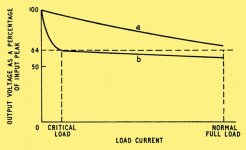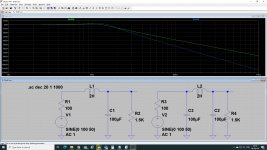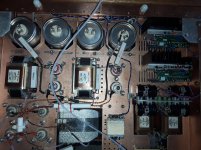For a good design in power supply filtering for audio (tubes) I read that one must take into into account several parameters, including the Lc that is the critical value of the input inductance. This is true when using an LC filter, where Lc>Rl/6*pi*f, but the same can be neglected with a pi-filter, CLC. Since I'd like to use a relatively small filter choke, someone could explain this rule (and the role of the input C)? Thanks.
> Search engine and reference books are a good start.
^ +1
The deeper answer is to figure the ripple reduction per dollar of Aluminum and per dollar of Iron. If it is 1920 you can't even get Al electrolytics and you use a lot of iron. If it is 2020, Al uFd is a lot cheaper than Iron so....
^ +1
The deeper answer is to figure the ripple reduction per dollar of Aluminum and per dollar of Iron. If it is 1920 you can't even get Al electrolytics and you use a lot of iron. If it is 2020, Al uFd is a lot cheaper than Iron so....
> Search engine and reference books are a good start.
^ +1
The deeper answer is to figure the ripple reduction per dollar of Aluminum and per dollar of Iron. If it is 1920 you can't even get Al electrolytics and you use a lot of iron. If it is 2020, Al uFd is a lot cheaper than Iron so....
Yes, nowadays you can sure skimp with Al electrolitics! And I don't stand back...
As for a theoretical treatment on the subject, I will look for some understandable "source".
Hello,
Sure it is true that capacitors get much smaller. BUT i think that using an input choke will always be better than just adding more capacitors.
We must now how much current your preamp/amp needs.
My ezxperience is that making the inductance of the input choke higher is always good.
With a choke input you will need a power transformer with a higher output voltage.
So give us some more information.
Take a look at this figure.
Greetings, Eduard
Sure it is true that capacitors get much smaller. BUT i think that using an input choke will always be better than just adding more capacitors.
We must now how much current your preamp/amp needs.
My ezxperience is that making the inductance of the input choke higher is always good.
With a choke input you will need a power transformer with a higher output voltage.
So give us some more information.
Take a look at this figure.
Greetings, Eduard
Attachments
LC filter is good IF the L is good, from a mechanical standpoint.
Sadly, it's very difficult to predict: I've had great ones from China and the US, and I've had 1 from Germany that buzzed like hell.
Sadly, it's very difficult to predict: I've had great ones from China and the US, and I've had 1 from Germany that buzzed like hell.
Hello,
Sure it is true that capacitors get much smaller. BUT i think that using an input choke will always be better than just adding more capacitors.
We must now how much current your preamp/amp needs.
My ezxperience is that making the inductance of the input choke higher is always good.
With a choke input you will need a power transformer with a higher output voltage.
So give us some more information.
Take a look at this figure.
Greetings, Eduard
Current demand is 100mA for 160V.
In reality I tried to wind by miself the choke, after learning some theory and pratical trick on how to make it.
An approximate measurement of the inductance gave me quite a reliable valu (taking into account the domestic procedure). Laminations and air gap was optimal for an L value from 3 to 5 H, but I kept lower with L ~ 2H (compatibly with the availability of wire).
I know winding technique wasn't the best. Instead a wire-by-wire tight winding and every layer interleaved by paper sheet, I winded the choke "randomly" and just with 3 fish paper layers in the complex. Anyway after I tested it like a CLC filter, it didn't seem bad to me: hum was much lesser than previous filter I made, CRCRC. Of course, with a serious winding machine and improved skills results could be better.
I made an estimate of the ripple for a CLC filter with the use of identical capacitors C1, C2. And then the difference from an LC filter, both in my case (disregarding the restrictions for L):
1) LC:
1) LC:

with Xc= 1/2*pi*f*C and Xl= 2*pi*f*L
assuming f= 50Hz, C=100uF and L=2 H
then γ= √2/12*pi2*f2*C*L = 0.02
2) CLC:

same parameters like above, plus Rl=1500 ohm
...then γ= √2/64*pi3*f3*C1*C2**L*Rl= 0.0002
Based on this the difference is a factor of 100 (due to Rl contribution), that is 3V ripple against 30mV. I hope my maths is ok...
Uh-uh, no way: LC is a 2nd order filter, CLC is 3rd. To get a 40dB difference, you need to go up to the KHz region.
PSU Designer is good for these things, LTspice is better.
Yes, I see...I 'll take a look with Psud.
Hello,
So find a choke that has enough Henry to be used as an input choke. Install a load resistor so there will always be the minimum current draw needed. Then just make a simple LCRC supply.
Greetings, Eduard
So find a choke that has enough Henry to be used as an input choke. Install a load resistor so there will always be the minimum current draw needed. Then just make a simple LCRC supply.
Greetings, Eduard
That's the idea.
Attached is a schematic of the main PS for my preamp; additionally, there's a RC filter per stage.
A rough rule of thumb: a good head L is $20+ from China, $50+ from elsewhere, plus shipping. Don't cheap out on this one, or use CRC.
Attached is a schematic of the main PS for my preamp; additionally, there's a RC filter per stage.
A rough rule of thumb: a good head L is $20+ from China, $50+ from elsewhere, plus shipping. Don't cheap out on this one, or use CRC.
Attachments
That's the idea.
Attached is a schematic of the main PS for my preamp; additionally, there's a RC filter per stage.
A rough rule of thumb: a good head L is $20+ from China, $50+ from elsewhere, plus shipping. Don't cheap out on this one, or use CRC.
Thans for suggestion. It is a good multi-stage filter on your preamp...did you use MKP caps for low capacitance filtering? About mine, I don't mean to use that choke I'm testing...it is just a trial.
...did you use MKP caps for low capacitance filtering? ...
All my downstream electrolytics are Rubycon MXC 220uF 450V 105°C, same as the main PS, bypassed with 2.2uF MKP.
Last edited:
Hello,
I think if you want to have the biggest return on investment you should just buy a Lundahl choke. They are perfect to be used as input chokes and there are a lof values available. The higher the number of Henry the less current you need to '' waiste '' on the load resistor. If you have 160 volts DC on the first capacitor after the choke and you are using a 10H choke. The load resistor has to take a minimum current of 160/10 =16 mA . So you can get a 10H 150 mA choke. If you use a 20 H choke there is no need for 16 mA but just 8 mA .
It COULD be tricky using Chinese parts i remember buying a lamppost in Vietnam which came with a Chinese made power cord. It was a solid core steel wire with some copper cladded on the outside. A choke input choke is a tricky thing to make. In my power supplies i have used several ones and Lundahl was always a winner. greetings, eduard
I think if you want to have the biggest return on investment you should just buy a Lundahl choke. They are perfect to be used as input chokes and there are a lof values available. The higher the number of Henry the less current you need to '' waiste '' on the load resistor. If you have 160 volts DC on the first capacitor after the choke and you are using a 10H choke. The load resistor has to take a minimum current of 160/10 =16 mA . So you can get a 10H 150 mA choke. If you use a 20 H choke there is no need for 16 mA but just 8 mA .
It COULD be tricky using Chinese parts i remember buying a lamppost in Vietnam which came with a Chinese made power cord. It was a solid core steel wire with some copper cladded on the outside. A choke input choke is a tricky thing to make. In my power supplies i have used several ones and Lundahl was always a winner. greetings, eduard
Attachments
Funny: contrarily to the title, there's no mention of the critical inductance in this thread 🙂
Critical inductance = Rl / 900 @ 50Hz [H]
Where Rl = equivalent load resistor, in my case 7000 Ohms, which gives a minimum of about 8H; factoring in a 2x safety margin gives 20H. The amperage needs to be uprated as well, the more the merrier.
Critical inductance = Rl / 900 @ 50Hz [H]
Where Rl = equivalent load resistor, in my case 7000 Ohms, which gives a minimum of about 8H; factoring in a 2x safety margin gives 20H. The amperage needs to be uprated as well, the more the merrier.
Hello,
Because the original poster was still searching lol. I honestly think if you wanna use only one choke it will be best to go for a LCRC supply. Now already enough info in this thread to get things started. Greetings, eduard
Because the original poster was still searching lol. I honestly think if you wanna use only one choke it will be best to go for a LCRC supply. Now already enough info in this thread to get things started. Greetings, eduard
Hello,
Because the original poster was still searching lol. I honestly think if you wanna use only one choke it will be best to go for a LCRC supply. Now already enough info in this thread to get things started. Greetings, eduard
As you mentioned, Lundahl makes very good transf. and chokes...I have to see if I can find one in my country without spending a fortune.
You said that LCRC filter is probably the best choice (like that it was done especially in the old tube amps). But many examples around and builders too actually use CLC instead, often with cap multiplier, regulators setups etc...That is just to say.
Funny: contrarily to the title, there's no mention of the critical inductance in this thread 🙂
Critical inductance = Rl / 900 @ 50Hz [H]
Where Rl = equivalent load resistor, in my case 7000 Ohms, which gives a minimum of about 8H; factoring in a 2x safety margin gives 20H. The amperage needs to be uprated as well, the more the merrier.
So, in my case a 5H/150mA choke could do the job...
- Home
- Amplifiers
- Power Supplies
- Filter choke critical inductance



